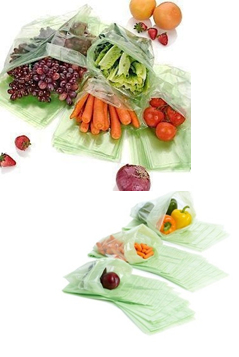
 KEEP-IT-FRESH Master batch can be used to produce plastic bags and containers with special properties of shelf life enhancement of fresh fruits, vegetables and flowers from 40% to 400%.
KEEP-IT-FRESH Master batch can be used to produce plastic bags and containers with special properties of shelf life enhancement of fresh fruits, vegetables and flowers from 40% to 400%.
Fresh fruits, vegetables and flowers start to ripen after harvesting and during the ripening process, these products release ethylene gas. This ethylene gas, when in the package increases the ripening rate of the fresh product. Hence, the ripening process is accelerated which results in faster rotting of the fresh product. The ethylene gas produced works as an auto catalyst for ripening, which in turn produces higher sugar levels causing microbial spoilage of the products.
The plastic products produced by using KEEP-IT-FRESH MB absorb the harmful ethylene gas produced hence slowing the ripening and rotting process, and increasing the shelf life of the packed product.
The Master Batch packaging products have been shown to increase shelf life of bananas by up to 5 times, and improves the shelf life of tomatoes by up to 3 times.
Tests performed on the tomatoes show that the product kept in the open started to rot in 5 days, where as the ones in the KEEP-IT-FRESH bags were good even on the 10th day. Comparatively, tomatoes kept in generic plastic bags developed black spots and mold by the 6th day.
Download the Keep-It-Fresh Flyer
Download the Keep-It-Fresh Presentation
Features:
- Easily processable with Polyethylene
- FDA Compliant (SGS Report)
- Natural Additives
- Effective at low addition levels of 6-7.5%
- Human Safe
- Ecologically Safe
- Recyclable
- Organic
- Anti-Microbial
Application:
- Add 6-7.5% of MB in PE
- Process at the same processing conditions recommended for the base polymer
- Compatible with LLDPE/LDPE/HDPE/HMDPE
- May cause negligible drop in transparency and gloss
Testing & Certifications:
- FDA compliant with FDA 21 CFR 177.1520 Clause (a) (1) (i) (Download test results)
Safety Information:
KEEP-IT-FRESH MB does not contain Lead (Pb), Mercury (Hg), Cadmium (Cd), Hexavalent Chromium (Cr6), Polybrominated biphenyls (PBB), or Polybrominated di-phenylether complying with the restricted substances listed in Article 4(1) of the RoHS Directive.
Disclaimer: This Data sheet and information it contains is considered to be accurate at the date of printing. No representation or warranty, expressed or implied is made as to the accuracy or completeness of the data and information contained in this publication. The seller does not undertake any responsibility for consequential liabilities or damages arising due to the use of the products or their performance. It is the User’s obligation to evaluate and use products safely and within the scope advised in the data sheet and to comply with all applicable laws and regulations
